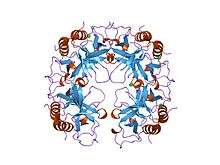CcdA/CcdB Type II Toxin-antitoxin system
| CcdB Toxin of Type II Toxin-antitoxin system | |||||||||
|---|---|---|---|---|---|---|---|---|---|
 ccdb, a topoisomerase poison from e. coli | |||||||||
| Identifiers | |||||||||
| Symbol | CcdB | ||||||||
| Pfam | PF01845 | ||||||||
| InterPro | IPR002712 | ||||||||
| SCOP | 4vub | ||||||||
| SUPERFAMILY | 4vub | ||||||||
| |||||||||
| CcdA Antitoxin of Type II Toxin-antitoxin system | |||||||||
|---|---|---|---|---|---|---|---|---|---|
| Identifiers | |||||||||
| Symbol | CcdA | ||||||||
| Pfam | PF07362 | ||||||||
| Pfam clan | CL0057 | ||||||||
| InterPro | IPR009956 | ||||||||
| |||||||||
The CcdA/CCdB Type II Toxin-antitoxin system is one example of the bacterial toxin-antitoxin (TA) systems that encode two proteins, one a potent inhibitor of cell proliferation (toxin) and the other its specific antidote (antitoxin). These systems preferentially guarantee growth of plasmid-carrying daughter cells in a bacterial population by killing newborn bacteria that have not inherited a plasmid copy at cell division (post-segregational killing).[1]
The ccd system (control of cell death) of the F plasmid encodes two proteins, the CcdB toxin (101 amino acids) and the CcdA antidote (72 amino acids). The antidote or antitoxin prevents CcdB toxicity by forming a tight CcdA–CcdB complex. The target of CcdB is the GyrA subunit of DNA gyrase, an essential type II topoisomerase in Escherichia coli.[2]
CcdB protein is a topoisomerase poison from Escherichia coli.[3] It is responsible for killing plasmid-free segregants, and interferes with the activity of DNA gyrase. It acts to inhibit partitioning of the chromosomal DNA.
Regulation of the ccd operon by the CCdA/CCdB complex is dependent upon the ratio of the two molecules to each other in the complex: a (CcdA)2–(CcdB)2 complex binds the DNA of the operon thus repressing transcription, but when CcdB is in excess of CcdA de-repression occurs, whereas repression will occur when CcdA levels are greater than or equal to that of CcdB. As a model system, by ensuring an antidote–toxin ratio greater than one, this mechanism might prevent the harmful effect of CcdB in plasmid-containing bacteria.[4]
The Ccd and parD systems are found to be strikingly similar in terms of their structures and actions. The antitoxin protein of each system interacts with its cognate toxin to neutralise the activity of the toxin and in the process the complex of the two becomes an efficient transcription repressor.[5]
External links
References
- ↑ Bahassi EM, O'Dea MH, Allali N, Messens J, Gellert M, Couturier M (1999). "Interactions of CcdB with DNA gyrase. Inactivation of Gyra, poisoning of the gyrase-DNA complex, and the antidote action of CcdA.". J Biol Chem. 274 (16): 10936–44. doi:10.1074/jbc.274.16.10936. PMID 10196173.
- ↑ Madl T, Van Melderen L, Mine N, Respondek M, Oberer M, Keller W, et al. (2006). "Structural basis for nucleic acid and toxin recognition of the bacterial antitoxin CcdA.". J Mol Biol. 364 (2): 170–85. doi:10.1016/j.jmb.2006.08.082. PMID 17007877.
- ↑ Loris R, Dao-Thi MH, Bahassi EM, Van Melderen L, Poortmans F, Liddington R, Couturier M, Wyns L (January 1999). "Crystal structure of CcdB, a topoisomerase poison from E. coli". J. Mol. Biol. 285 (4): 1667–77. doi:10.1006/jmbi.1998.2395. PMID 9917404.
- ↑ Afif H, Allali N, Couturier M, Van Melderen L (2001). "The ratio between CcdA and CcdB modulates the transcriptional repression of the ccd poison-antidote system.". Mol Microbiol. 41 (1): 73–82. doi:10.1046/j.1365-2958.2001.02492.x. PMID 11454201.
- ↑ Smith AB, López-Villarejo J, Diago-Navarro E, Mitchenall LA, Barendregt A, Heck AJ, et al. (2012). "A Common Origin for the Bacterial Toxin-Antitoxin Systems parD and ccd, Suggested by Analyses of Toxin/Target and Toxin/Antitoxin Interactions.". PLoS ONE. 7 (9): e46499. doi:10.1371/journal.pone.0046499. PMC 3460896
 . PMID 23029540.
. PMID 23029540.
This article incorporates text from the public domain Pfam and InterPro IPR009956